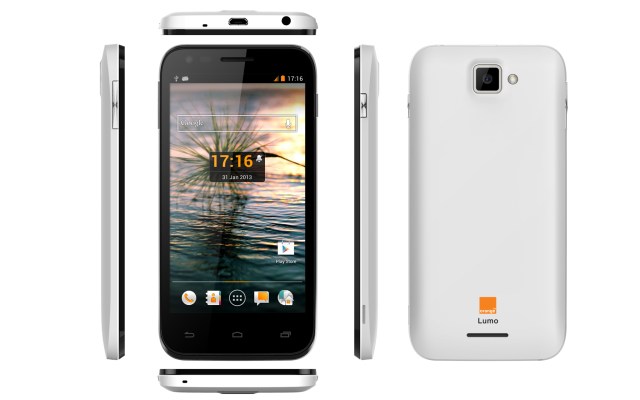Perhaps aware of the tsunami of news that will hit during Mobile World Congress, we are seeing an increasing amount of news releases coming out before the actual event. France Telecom/Orange has already told us about one device — an Android smartphone with Fujitsu aimed at the senior market — and now it is following that up with three more, own-branded, Android handsets aimed squarely at the middle market of smartphone users.
The Lumo (pictured) is the carrier’s first own-branded LTE device; the Nivo is a device aimed at the budget segment; and the San Remo is a large-screened 4.7″ device with a brushed-metal casing. All will be out in selected markets in the first half of this year.
And while each of these devices will come loaded with Android 4.1, Patrick Remy, the VP of devices for France Telecom, also notes that we may soon start seeing own-brand handsets from the carrier not built on Android. “There is no willingness to only have Android devices in this range,” he said. “We believe the best opportunity is with Android right now, but we are looking at other operating systems, specifically Windows Phone, but potentially others.”
On the subject of Firefox OS — the mobile platform being built by Mozilla with other partners — “we are monitoring what is being done there,” says Remy. “We are not announcing any launch of such devices at this point in time, but we are definitely interested in that area and depending on the opportunities, there is a chance for an Orange-branded device among those.”
Remy also admits that Orange’s own-brand smartphone devices do not move the needle when compared to the volumes sold by carriers from smartphone leaders Samsung and Apple. But they are proving to be small hits for the carrier, specifically when targeting users in the mid-market — or “higher-end pay-as-you-go or lower end contract customers,” in Remy’s description.
This naturally means these devices do best in markets where these segments are biggest. “Not Luxembourg,” Remy joked of the very affluent little principality where the carrier offers services. But other markets do quite well. In Spain last year, Orange’s best-selling device was the Monte Carlo, another handset in its own-brand range. Overall sales of this line of devices has grown by 62% over the last year. But it’s telling that there are currently “no plans” for any of these three to be offered in the UK this year.
France Telecom/Orange does not release sales numbers on how well these smartphones do but did note that last year its entire range of own-branded devices — including both feature phones and smartphones — were about 10% of all handset volumes, “and that’s increased a bit to about 12%,” says Remy. He notes that within that proportion smartphones are a “significant part of that.”
Orange has struck deals with Alcatel/TCL, Gigabyte, Huawei and ZTE to make its own-brand devices. The Lumo and Nivo come from Gigabyte, whereas the San Remo is made by Alcatel/TCL, with Huawei and ZTE sitting out in this particular round.
Perhaps more than other European telcos, Orange has over the years dedicated a lot of time and energy to creating devices that are filled with Orange-customized services and the Orange brand. These devices play into that theme, but for now will not be packing as much Orange-punch as they can.
Baidu, for example, which has inked a deal with Orange to provide a customized browser for its devices, will not be making an appearance on the devices for now, although this may be something we will see going forward, says Remy. “They’ll come with our standard suite of services and customization,” he noted. These include customized lock-screens, the ability to port your services when roaming, and links to Orange services specific to your home country.
